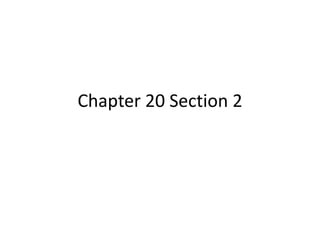
Chapter 20 section 2
- 1. Chapter 20 Section 2
- 3. Objectives • Describe the sit-ins, freedom rides, and the actions of James Meredith in the early 1960s. • Explain how the protests at Birmingham and the March on Washington were linked to the Civil Rights Act of 1964. • Summarize the provisions of the Civil Rights Act of 1964.
- 4. Terms and People • sit-in − a form of protest in which participants sit and refuse to move • Student Nonviolent Coordinating Committee (SNCC) − grassroots movement founded in 1960 by young civil rights activists • freedom ride − 1961 protest by activists who rode buses through southern states to test the ban on rider segregation on interstate buses • James Meredith − black Air Force veteran who enrolled at the all-white University of Mississippi
- 5. Terms and People (continued) • Medgar Evers − civil rights activist instrumental in the effort to desegregate the University of Mississippi • March on Washington − 1963 demonstration in which 200,000 people rallied for economic equality and civil rights • filibuster − tactic by which senators give long speeches in order to delay action on legislation • Civil Rights Act of 1964 − outlawed discrimination in public places and employment based on race, religion, or national origin
- 6. How did the civil rights movement gain ground in the 1960s? Through victories in the courts and the success of sit-ins and other nonviolent protests, African Americans slowly began to win their battle for civil rights. But it was the landmark Civil Rights Act of 1964 that signaled a dramatic change in race relations by outlawing discrimination based on race, religion, or national origin.
- 7. Student activists engaged in nonviolent civil disobedience to create change. • Students staged sit-ins. • Students formed their own organization, the Student Nonviolent Coordinating Committee (SNCC), to continue to work for equal rights.
- 8. Students also organized freedom rides to protest segregation on the interstate transportation system. • The Supreme Court had already ruled that segregation on interstate buses and waiting rooms was illegal. Freedom riders tested the federal government’s willingness to enforce the law. • Some of the buses and riders were attacked by angry prosegregationists. • President Kennedy intervened, ordering police and state troopers to protect the riders and mandating the desegregation of the interstate bus system.
- 9. In September 1962, Air Force veteran James Meredith tried to enroll at the all-white University of Mississippi. • The federal courts ordered the school to desegregate in 1962. • Mississippi’s governor resisted, creating a stand-off between the federal government and the state government. • When Meredith arrived on campus, a riot ensued; two men were killed in the fighting.
- 10. Once again, President Kennedy intervened, assigning federal marshals to protect Meredith. • Meredith graduated from the University of Mississippi in 1963. He later obtained a law degree from Columbia University. • Tragically, civil rights activist Medgar Evers, who was instrumental in helping Meredith gain admittance to “Ole Miss,” was murdered in June 1963.
- 11. In the spring of 1963, civil rights leaders focused their efforts on the South’s most segregated city—Birmingham, Alabama. • Initially, the protests were nonviolent, but they were still prohibited by the city. • City officials used police dogs and fire hoses against the protestors. • Rev. Martin Luther King, Jr., himself was arrested for violating the prohibition.
- 12. Reaction to the Birmingham protests was overwhelming. Shocked Americans demanded that President Kennedy take action to end the violence. Calling it a “moral issue,” Kennedy proposed sweeping civil rights legislation. Civil rights leaders held a March on Washington to pressure the government to pass the President’s bill.
- 13. On August 28, 1963, hundreds of thousands of people from all around the country gathered in Washington, D.C., to demonstrate. As millions more watched on television, Rev. Martin Luther King, Jr., stood before the Lincoln Memorial and delivered his unforgettable “I Have a Dream” speech.
- 14. In September 1963, less than three weeks after the march, a bomb exploded in the church that headquartered the SCLC in Birmingham. Four young African American girls were killed.
- 15. On November 22, 1963, President Kennedy was assassinated. Vice President Lyndon B. Johnson assumed the presidency. Johnson continued to work for passage of Kennedy’s civil rights legislation.
- 16. The legislation passed in the House of Representatives but faced more opposition in the Senate. A group of southern senators blocked it for 80 days using a filibuster. The measure finally passed in the Senate. Supporters put together enough votes to end the filibuster.
- 17. In July, the Civil Rights Act of 1964 was signed into law. • Banned segregation in public accommodations • Gave government the power to desegregate schools • Outlawed discrimination in employment • Established the Equal Employment Opportunity Commission